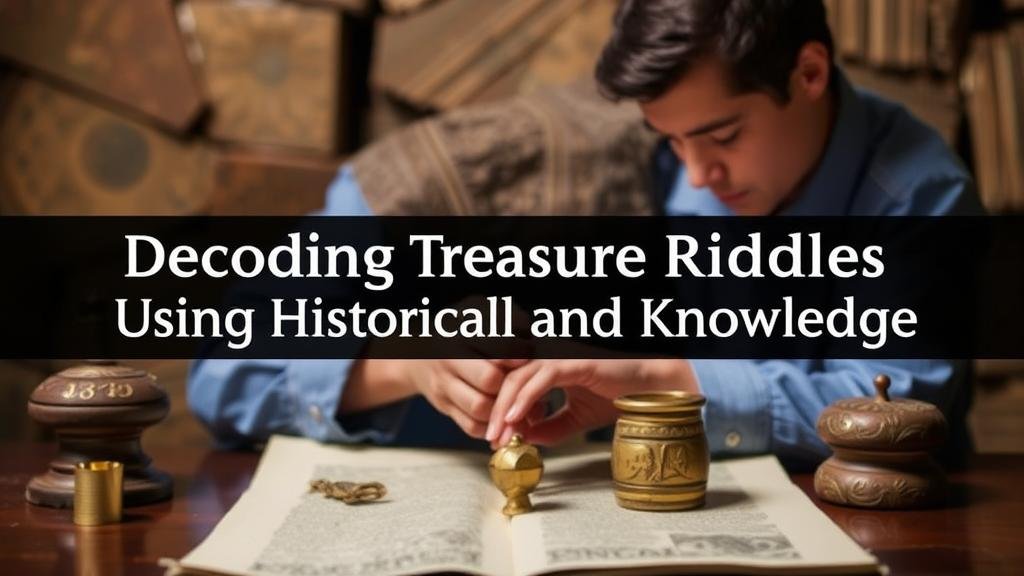Decoding Treasure Riddles Using Historical and Cultural Knowledge
Decoding Treasure Riddles Using Historical and Cultural Knowledge
The allure of treasure hunts has captivated the human imagination for centuries, often intertwined with intricate riddles that serve as both riddles and clues. These treasure riddles not only pose engaging puzzles but also hold significant historical and cultural references that add layers to their interpretation. This article explores the methodologies for decoding these riddles, emphasizing the importance of historical context, cultural symbols, and analytical techniques.
The Foundation of Treasure Riddles
Treasure riddles typically emerge from a rich repository of lore and myth, often designed to interlace the thrill of discovery with the rigor of intellectual challenge. r foundational structure usually consists of clues that reference specific cultural artifacts or historical events. Understanding this structure is essential for effective decoding.
- Symbolism: Many riddles utilize symbols derived from local mythology or geography.
- Historical Figures: References to prominent historical figures can provide context as well as clues, such as names of explorers or local leaders.
Historical Context: A Crucial Element
The first step in decoding treasure riddles is to establish a historical context. Historical knowledge allows treasure hunters to decipher clues that may reference particular events, periods, or locations.
For example, consider the legendary ‘Treasure of the Flor de la Mar’, a shipwreck laden with gold that sank off the coast of Malaysia in 1511. Riddles surrounding this treasure often incorporate elements from the early 16th-century maritime expeditions, requiring knowledge of Portugals colonial history and naval prowess to interpret clues accurately.
Cultural Knowledge: Understanding Symbolism
Cultural references within riddles can often relate to local traditions, folklore, or significant historical narratives. Understanding these references is crucial for solving the riddles effectively.
A poignant example can be seen in the riddle associated with the ‘Mona Lisa’ treasure hunt in Paris, where clues reference elements of French art and revolution: “Where the smile of the seer meets the flicker of the flame.†Here, knowledge of French cultural heritage, specifically the significance of art and revolution, informs the interpretation of the riddle.
Analytical Techniques for Decoding
Decoding riddles demands analytical skills that range from linguistic parsing to logical reasoning. By employing systematic methods, one can enhance their ability to uncover hidden meanings. Here are a few techniques:
- Keyword Analysis: Focus on keywords that may hold double meanings or idiomatic expressions.
- Contextual Background: Gather background information on the time period or cultural setting relevant to the riddle.
- Map Interpretation: Use maps or historical records to pinpoint geographical clues.
For example, in an archaeological dig where clues reference the ancient Roman Empire, understanding terms like thermae (public baths) or via (road) can guide hunters to discern the riddles intended location.
Case Studies in Successful Decoding
Numerous successful treasure hunts serve as exemplary case studies of historical and cultural knowledge application. Notably, the discovery of the Antikythera Mechanism highlighted the interplay between history and riddles.
In this case, the riddles were tied to astronomical events and the mechanism’s sophisticated engineering. Knowledge about Greek astronomy and historical context surrounding ancient shipwrecks proved essential for researchers attempting to fully understand the significance of the artifact.
Potential Challenges and Limitations
While decoding treasure riddles can be exhilarating, it also presents challenges. Riddles may be intentionally misleading or overly cryptic, requiring nuanced interpretation. Also, historical inaccuracies or cultural biases in the riddles conception can complicate the decoding process.
For example, riddles that rely on obscure historical anecdotes can lead to confusion. A treasure hunt referencing lesser-known local legends may leave participants with limited leads, highlighting the importance of thorough research.
Actionable Takeaways
Engaging with treasure riddles from historical and cultural perspectives requires a multi-faceted approach. Here are essential takeaways for aspiring treasure hunters:
- Conduct thorough research on the historical context relevant to the riddle.
- Develop an understanding of key cultural symbols that may feature in the riddle.
- Employ systematic analytical techniques to break down complex clues.
- Stay aware of potential biases and limitations in source materials.
Ultimately, decoding treasure riddles is not merely an intellectual pursuit; it is a journey that intertwines history, culture, and the thrill of adventure, guiding individuals through both time and imagination in their quest for hidden treasures.



